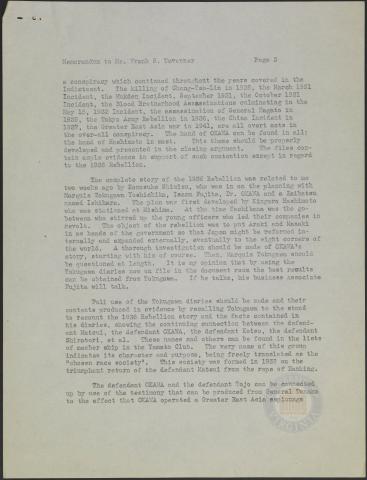
Page 2
| Parent | Completion of the Case Against OKAWA, Shumei August 28, 1946 |
|---|---|
| Date | 28 August 1946 |
| Language | English |
| Collection | Tavenner Papers & IMTFE Official Records |
| Box | Box 3 |
| Folder | General Reports and Memoranda from August 1946 |
| Repository | University of Virginia Law Library |
MEMORANDUM to Frank S. Tavenner Page 2
A conspiracy which continued throughout the years covered inn the Indictment. The killing of Chang-Tso-Lin in 1928, the March 1931 Incident, the Mukden Incident, September 1931, the October 1931 Incident, the Blood Brotherhood Assassinations culminating in the May 15, 1932 Incident, the assassination of General Nagato in 1935, the Tokyo Army Rebellion in 1936, the China Incident in 1937, the Greater East Asia war in 1941, are all overt acts in the over-all conspiracy. The hand of OKAWA can be found in all; the hand of Hashimoto in most. This theme should be properly developed and presented in the closing argument. THE files contain ample evidence in support of such contention except in regard to the 1936 Rebellion.
The complete story of the 1936 Rebellion was related to me two weeks ago by Konosuke Shimizu, who was in on the planning with Marquis Tokugawa Yoshichika, Isamu Fujita, Dr. OKAWA and a Zaibatsu named Ishihara. The plan was first developed by Kingoro Hashimoto who was stationed at Mishima. At the time Tachibana was the go-between who stirred up the young officers who led their companies in revolt. The object of the rebellion was to put Araki and Masaki in as heads of the government so that Japan might be reformed internally and expanded externally, eventually to the eight corners of the world. A thorough investigation should be made of OKAWA’s story, starting with him of course. Then, Marquis Tokugawa should be questioned at length. It is my opinion that by using the Tokugawa diaries now on file in the document room the best results can be obtained from Tokugawa. If he talks, his business associate Fujita was talk.
Full use of the Tokugawa diaries should be made and their contents produced in evidence by recalling Tokugawa to the stand to recount the 1936 Rebellion story and the facts contained in his diaries, showing the continuing connection between the defendant Matsui, the defendant OKAWA, the defendant Koiso, the defendant Shiratori, et al. These names and others can be found int eh lists of member ship in the Yamato Club. The very name of this group indicates its character and purpose, being freely translated as the “chosen race society”. This society was formed in 1938 on the triumphant return of the defendant Matsui from the rape of Nanking.
The defendant OKAWA and the defendant Tojo can be connected up by use of the testimony that can be produced from General Tanaka to the effect that OKAWA operated a Greater East Asia espionage
